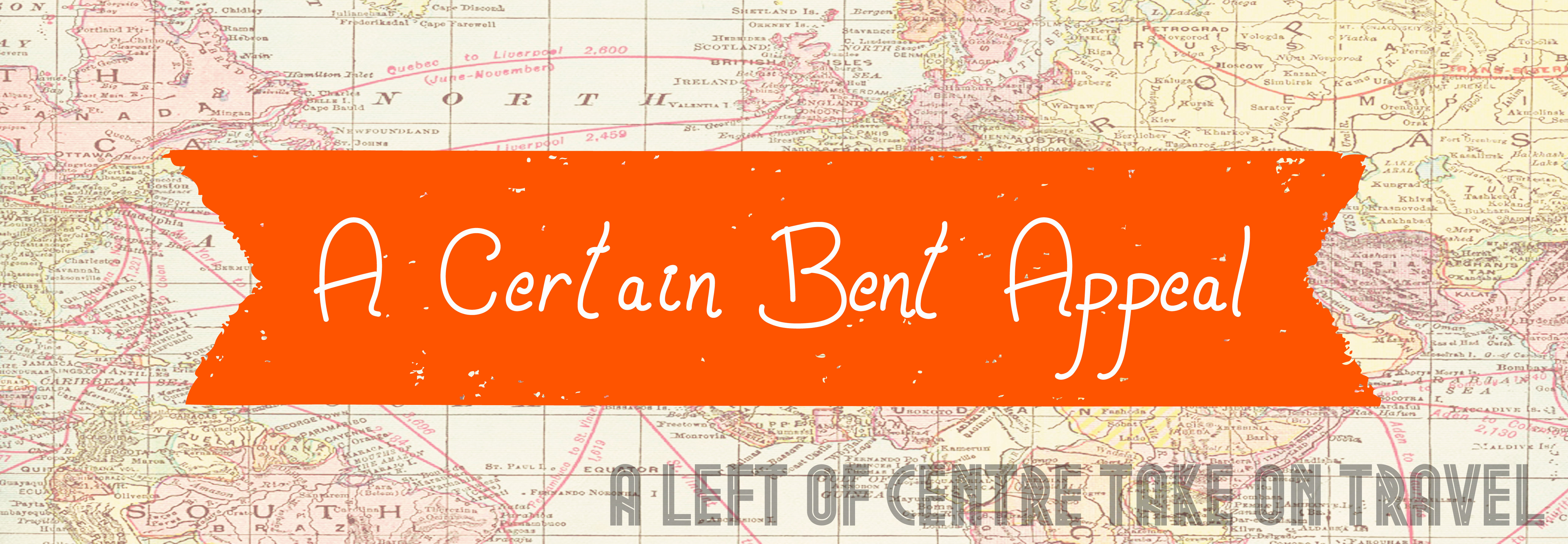 |
| The town of San Cristobal de las Casas. And Miguel, recently hurt. |
“Are you Mexican?” the bartender at the jungle bar in
Palenque asked Miguel incredulously.
My boyfriend, who has never left Mexico and is used to being
part of its homogenous culture, looked surprised at the question. Perhaps even
flattered; for once he was the
foreigner. I looked around. The bar was filled with people of all shapes and
sizes speaking a cornucopia of languages. A fascinating mix for sure, but we
were in Mexico—where were the Mexicans?
It was when we boarded the bus for San Cristobal de las
Casas (as part of a two-week trip through southern Mexico) that we realized
that we were on a well-worn backpacker route. The faint smell of body odor was
the first indication, then the potpourri of scruffy bodies clad in various
types of indigenous gear—knit ponchos, woven fedoras, brightly coloured bags,
toe shoes (or even lack of shoes). The Spanish accents were Argentinian and the
English accents were British. We were on the tourist trail, albeit one a little
funkier than your standard eat-sleep-and-shit resort package.
Our first encounter with San Cristobal was on a rainy
weekday morning. We noted the brightly painted churches, the rough streets, the
mountains rising dramatically in the distance. Though we were wet and damp our
spirits were intact. We thought we’d found a modest and relaxed pueblito, the perfect place to cool our
heels for a few days.
Then the hippies started to emerge.
Bleary-eyed and clutching extra-strong Americanos, they
began to trot out into the misty street in groups of twos and fours, guitars in
tow. We sat in a French pastry shop munching on custard puffs and listening to a
beanpole American regale a group of dreadlocked girls about his desire to
journey on wherever his heart took him. Then they began to trade drug stories.
Exhausted by our eleven hour bus ride, Miguel and I
retreated from this strange half-Mexico into our hotel room. We emerged after
dark rubbing our eyes sleepily and were immediately blinded by the spectacle in
front of us. The true nature of San Cristobal revealed itself to us.
The narrow streets were thronged with people and lined with
a dizzying array of amber jewelry stores, embroidered smock outlets, tapas and
Turkish restaurants, London-style pubs, and organic breakfast joints. The
crowd, an eclectic mix of dedicated hippies and leftist yuppies, trolled the
streets languorously. They stopped to take in a puppet show or a fire-eating,
bowler hat-wearing, tricycle-riding performer with an obvious penchant for both
sexes.
We plunged into this madness, picking up a woolly sweater
from one of the traditionally-dressed women in long dark braids. Thus suited up
for a frigid night in the Chiapas mountains, we indulged in a spread of
Lebanese food and sickeningly sweet Mexican wine.
“This place is like Disneyland for hippies,” I said to
Miguel.
The next morning the streets were quiet, though a brave pack
of hippies still tapped away on their drums outside our hotel. We packed into a
vegetarian restaurant for something resembling health food, if chilaquiles can be counted as such, and
then rambled about the streets. More English language bookstores, upmarket
jewelry shops, world food restaurants, and tour outfits presented themselves.
We decided to walk north to the market for a reprieve from tourist central.
Ahhh, here was Mexico.
The market, a sprawling labyrinth of dried beans, pungent
flowers, headless chickens, and piles of pine boughs pressed in insistently
from all sides. Aside from the occasional shuffling hippie, the market was
uniformly Mexican. Even further north was the rutted streets clogged with cars
and bicycles, torta puestos,
counterfeit DVD joints, grotty ice cream parlours, and other hallmarks of the
Mexico that I knew and begrudgingly loved.
 |
| The Maya village of San Juan Chamula |
My disbelief turned into discomfort as we entered the town. A
veritable hovel, it still seemed well-trafficked by tour groups. A gaggle of Germans
stood alongside us in the astonishing church that was dotted with hundreds of
candles, lined with figures of saints, and filled with streamers and plants. A
leathery old man keened and moaned; the German tourists watched him. Outside we
ate corn slathered in mayo and chili and watched the procession of supposedly
normal indigenous life.
Poverty tourism—this is what this was. I had visited Ward
Nine a year and a half ago, the area most affected by Hurricane Katrina in New
Orleans. While I thought it important to see the reality of American
inequality, it didn’t feel right to snap photos of condemned houses where
people still lived. Your vacation photo, their awful reality. Something about it
wasn’t quite right.
From San Cristobal we headed to the jungle in Palenque. In a
nearby bar we drank strawberry mojitos and enjoyed the privilege of being on
vacation. And here were our fellow travelers, similarly seeking pleasure and
the chance to experience another culture.
And yet, were we even in Mexico? Did it even matter? Similar
bars awaited in Guatemala, Costa Rica, Panama, and further afield. We could
have easily continued on this happy trail, drinking more mojitos and meeting
people from all over the world, then venturing out to experience “real
culture.” It seemed like a wonderful experience and not without real merit, but
if it meant that my Mexican boyfriend was a foreigner in his own country, I
couldn’t help but wonder if something crucial was being lost.
Reading List:
Reading List:
- Moon Chiapas
- Moon Yucatan Peninsula: Including Chiapas
- Rough Guide Mexico 9e
(I use this guide and it works well, though generally I prefer the Moon series).
Note: this article was originally published in the excellent website Mutante








8 comments:
Good article. A similar phenomenon exists in the tourist trail of parts of Asia.
Thanks Finn! Ah I will soon find that out as I am doing a tour of SE Asia early next year. Still, I recognize you can always get off that trail. And sometimes it exists for a reason--some amazing sights are to be seen along the way.
This was a refreshing read. Commenter Finn hit the nail on the head, the SE Asia trail has become laughably trendy in my opinion. I don't understand why people travel thousands of miles only to spend all their time with hoards of other westerners in a commercialized facade of the region they're visiting. "Just to say they did it", facebook pictures, and other forms of social brownie points are the only reasons I can think of. Anyway, the world is getting smaller and globalization will leave no stone left unturned, so what do you expect? It's an incredible time to be alive and I'm incredibly grateful to be able to travel internationally, so I shouldn't complain. Thanks again.
I have newer been to Mexico before but now I will include it to my travel list. I think that this country is very interesting and worthy visiting. I like to discover new foreign cultures and traditions because this is very interesting and useful. This information will obviously help you to know how to write a good thesis statement and to develop yourself in a great way.
Hello. Thank you for the interesting story. I can say as a college consultant - you write easily and interestingly. It's great!
You are right - in this small town is not very interesting.
San Cristobal de las Casas is the most picturesque town in Mexico. Knowingly in 2003 he was awarded the title of "Magic City". The city is located at an altitude of 2100 m above sea level, in the picturesque valley of Vall de Jovel. And unlike many other cities in Mexico, it does not have pre-colonial history. It was founded in 1528 by the Spanish conqueror. The city changed its name several times and began to be called San Cristobal only in the 19th century, in honor of Saint Cristobal. Now the town and villages near it are inhabited mostly by the Tzotzil and Tzeltal peoples, which belong to the Maya group of Indians. Local people still wear national clothes, use donkeys to transport cargo and arrangement Indian rites.
We boarded a combi headed for the indigenous village of San Juan Chamula. Here was an entirely different reality and the poorest one I’d seen in Mexico to date. Higgly-piggly shacks dotted the scrappy terrain. Herds of black-skirted women trudged along long mountain paths. Signs congratulating the newly elected governor competed with ads for Coca-Cola products. 4ocean bracelet chile , 4ocean bracelet germany ,
Thank you foor being you
Post a Comment